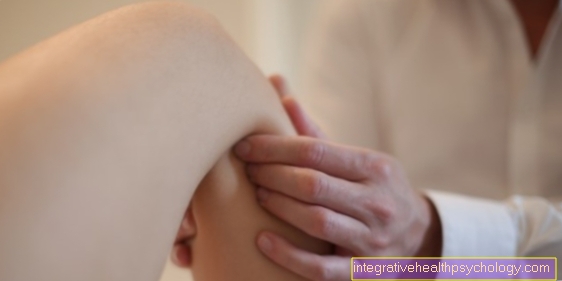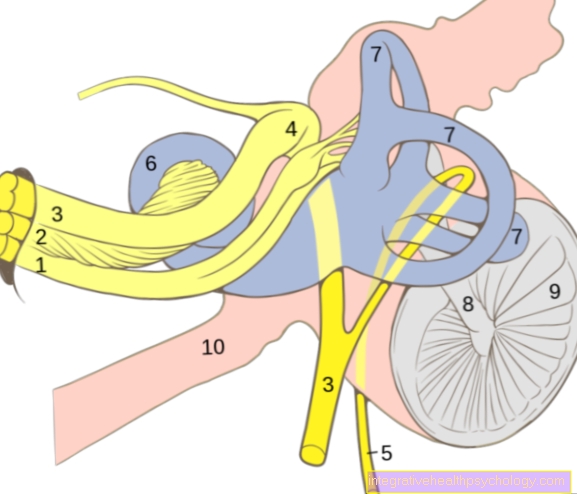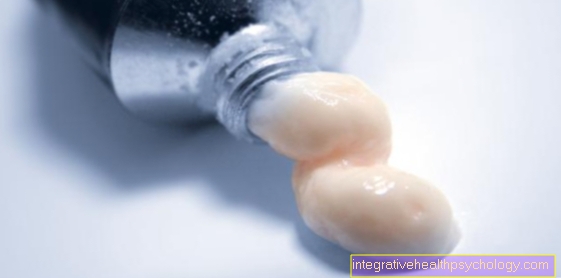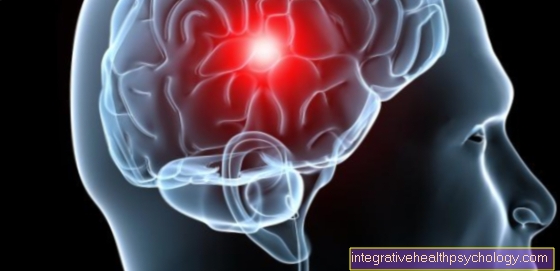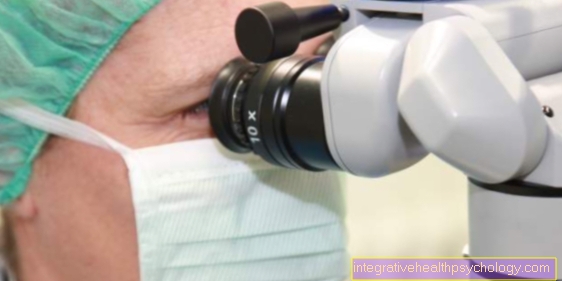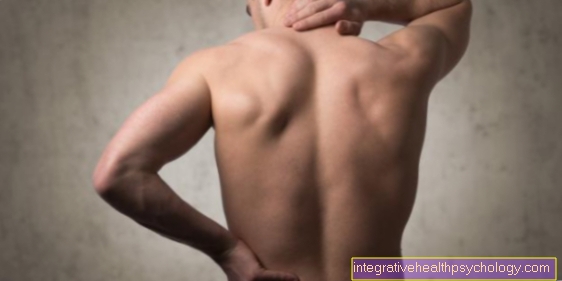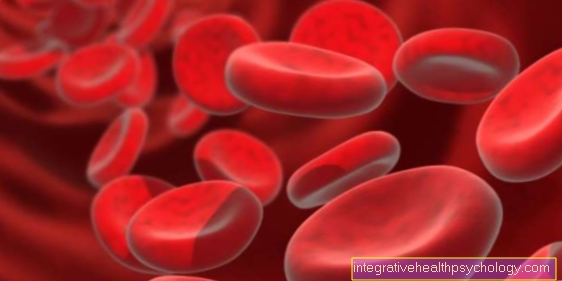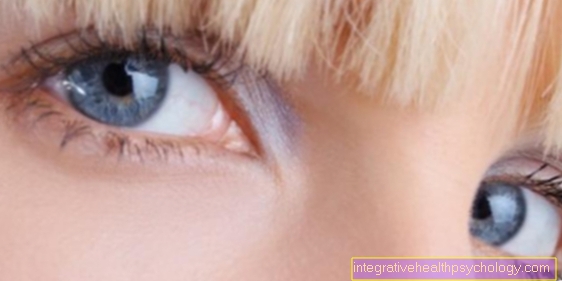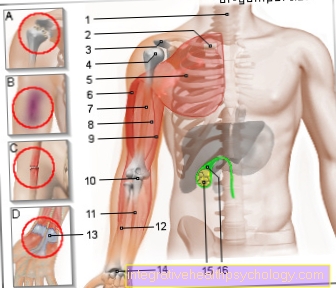Bone building
Synonyms
Bone structure, bone structure, skeleton
Medical: Os
English: bone

Bone building
Due to the structure of the bones, two types of bone are distinguished:
- of the braided bones and of the
- Lamellar bone
The braid-like bone resembles an ossification of the in terms of its structure and bone structure Connective tissue. It occurs mainly in humans in their developmental phase.
In adults it is only found in the Labyrinth capsule and near the seams of the skull bones.
Of the Bone building consists of four different layers:
- Outside is the Periosteum (Periosteum),
- this is followed by the layer of Compact and then
- the layer of Cancellous bone.
- Inside is still that inner periosteum (Endost) on.
1. The periosteum
The periosteum consists of a tight, network-like collagenous connective tissue layer, the inner layer of which (Cambium layer) is loosely built and has numerous blood vessels and nerves running through it. This layer consists mainly of osteoblasts and their stem cells. The outer layer (Stratum fibrosum) is made of elastic fiber braid and tightly arranged collagen fiber bundles (Sharpey fibers) educated. Together with the collagen fibers from attaching tendons, they radiate into the bone and anchor the tendon. In the outer layer are the artery and the nutricia vein, which lead through holes into the interior of the bone.
2. The compact
The compact is a tightly packed bone substance, from which approx. 80% of all skeletal mass is made up. The remaining 20% of the skeletal mass is made up of cancellous bone. The compacta is located in the entire outer area of a long bone. The compact consists of small, circular bone structures, the so-called osteons, which are approx. 1 cm long and approx. 250-350 µm in diameter. In the center of the Havers canal there is a vessel, nerve fibers and loose connective tissue around which 5-20 layers of collagen fibers running helically around the axis of the osteon are embedded.
Each layer is 5-10 µm thick and runs at a different angle of inclination to the one below. The arrangement of the collagen fibers depends on the mechanical load and is based on this. If the angle of inclination of the collagen fibers is flat, the osteon is more resistant to pressure; if the angle of inclination is steep, the osteon is tensile.
This specific arrangement of the collagen fibers and the high content of mineral salts in the extracellular matrix give the bone its high dimensional stability. The osteocytes are located between the collagen fiber layers. Their appendages protrude far between the layers and are connected to each other. Nutrients and oxygen from the blood vessels reach all cells via these processes and thus secure their nutrition. Outside around the osteon, the putty or cement line with a thickness of 1-2 µm forms the outer boundary.
Switching lamellae are fragments of old osteons between the other osteons. The outer general lamella is located directly under the outer periosteum, while the inner general lamella is located under the inner periosteum. The blood vessel in Haversian Canal is perpendicular to the artery and vein nutriciathat lead from the outside into the bones.
In addition, the Haversian canals running lengthways in the bone are connected by short, transverse and oblique Volkmann canals.
Figure bone structure

a - epiphysis
(Bone end)
b - metaphysis
(active growth zone)
c - diaphysis
(Bone shaft)
- Sponge-like built
Bone with red
Bone marrow -
Spongiosa substantia
+ Medulla ossium rubra - Epiphyseal line -
Epiphysial line - Dense (compact) bone -
Substantia compacta - Medullary cavity with yellow
Bone marrow -
Cavitas medullaris
+ Medulla ossium flava - Bony artery -
Nutrician artery - Periosteum -
Periosteum - Osteon (basic functional unit) -
Osteonum - Spaces filled with bone marrow
between the trabeculae -
Medulla ossium - Growth plate -
Lamina epiphysialis
You can find an overview of all Dr-Gumpert images at: medical illustrations

Long bones
(Long bones) - blue
Short bones - orange
Plate bone - yellow
Mixed forms - purple
- Brain skull -
Neurocranium - Facial skull -
Viscerocranium - Cervical vertebrae -
Vertebrae cervicales - Collarbone -
Clavicle - Shoulder blade - Scapula
- Sternum - sternum
- Humerus - Humerus
- Ribs - Costae
- Lumbar vertebrae -
Vertebrae lumbales - Cubit - Ulna
- Spoke - radius
- Sacrum - Sacrum
- Hip bone - Os coxae
- Femur - Femur
- Kneecap - patella
- Fibula - Fibula
- Shin - Tibia
You can find an overview of all Dr-Gumpert images at: medical illustrations
3. The cancellous bone
The Cancellous bone The bone structure is built up like a sponge and forms a three-dimensional framework of thinner and thicker trabeculae, rods and plates, the so-called lattice-like arranged Cancellous bone lugs.
Through this structure lie more than 60% the bone surface in the area of the Cancellous bone. The bone substance of the cancellous bone is also arranged like a lamella, but has no blood vessels. This leads to the Cancellous atrabula only a thickness of 200-300µ have to do so even more by diffusion from the adjacent Medullary canal to be fed.
The marrow cavity of the bone structure is filled either with fatty tissue or with blood-forming tissue. Due to the alignment of the cancellous trabeculae, the bone is able to functionally deform. This creates compressive and tensile forces through bending forces within the bone, which in turn lead to the formation of pressure and tensile trabeculae.
Through this function, the bone is able to adapt structurally to the function and the changed static conditions throughout its life. In the cancellous bone, the rate of remodeling is about three times as high as in the compact bone. While cultivation predominates in the growing age, degradation predominates after the age of 50, whereby age-related hormonal changes play a decisive role. As a result of these growth and renovation processes, old lamella systems are dismantled and new ones are built. The dismantling is carried out by the Osteoclasts. These are bone cells that are specialized for degradation. The structure then takes place via the Osteoblasts. The first generation of osteons, which were created through the remodeling of woven bones, are called primary osteons, those in the process of being remodeled are called switching lamellae and the osteons that have already been remodeled are the secondary osteons.
4. The Endost
The Endost from bone structure is a thin cell layer that is formed from bone cover cells. The composition depends on age and location. When grown up, about 5% of the total area is covered with osteoblasts and osteoclasts, which are responsible for remodeling and degradation processes, 95% is formed from the bone cover cells.
Stem cells of the bone
Besides the Osteocytes, Osteoblasts and Osteoclasts there are also the precursor cells of the osteoblasts as Stem cells in the bone.
These stem cells can divide and develop into osteoblasts. The osteoblasts are where bone is formed.
They lie in the tissue as a round layer that is connected by cell extensions and initially produce one non-mineralized matrixwhich is called an osteoid and has collagen fibers. After 8-10 days there is then a storage of Calcium phosphate salts and the osteoblasts wall themselves in, so to speak.
Then they differentiate further Osteocytes. The osteoclasts are large multinucleated cells that arise from immigrated blood cells and have developed the ability to break down bone tissue. They are in close contact with the bone matrix and form resorption cavities on its surface (Howship lacunae) in which the bone matrix is broken down by enzymes. The osteoclasts are still present in relatively large numbers in the growing bone; in the differentiated lamellar bone they are only found at points of active bone remodeling. This is about 1% of the internal bone surface.
During the day, osteoclasts can eat 40-70 µm into the bone and break down as much tissue as around 100 osteoblasts previously built up. All bone building and degrading processes take place on the outer and inner surfaces of the bone with the participation of the outer (Periosteum) and inner periosteum (Endost) instead of.
With the exception of the articular surfaces covered with cartilage and the tendon attachments, the outside of the bone is surrounded by the periosteum. The endostrum covers the inner surface of the compacta, the Haversian and Volkmann canals as well as all trabeculae of the cancellous bone. The estimated surface of the periosteum in adults is about 0.5 m², that of the endosteum is about 11 m².

